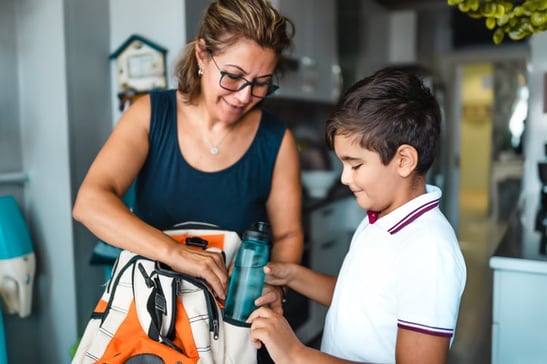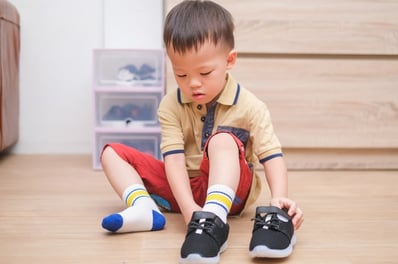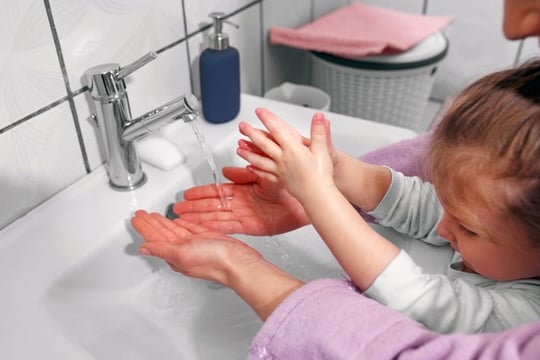Using Task Analysis for Arrival and Dismissal Routines
Getting ready to go somewhere and transitioning once you arrive just might be the hardest part of the day for your autistic child or student, and in turn, for you. Fortunately, tools like task analysis (TA) can help take the stress out of coming and going, to let you and yours take comfort in predictable routines.
Developing a Plan
Most of the time, for most adults, preparing to go or leave somewhere is like second nature. In our heads we’re ticking off the steps: “OK, I need to put on my shoes, grab my bag, and don’t forget my coffee” on our way to the door. This is the sign of a well-developed executive function—or in my case, semi-well-developed, as I often find myself going back and forth to grab things I’ve forgotten for the next several minutes.
Autistic students—and adults like me at times—need extra help in remembering the steps for getting ready to transition. This is where TA can assist.
Step 1: Find the Weak Points
I knew I needed to intervene and make a plan for home arrival when my house looked like a tornado hit after my daughter came in from the car after her first week of school. I realized it was because I’d never outlined what I wanted her to do. All I knew was I did not like what was happening. When there is no plan in place, children will improvise—so in this case I had shoes and backpack contents strewn across the house and a meltdown brewing over the lack of cheese in the refrigerator.
Figuring out a plan was easy when I stopped to pinpoint issues in the transition:
- Shoes and socks in the living room
- Backpack and papers scattered on the couches
- Teary toddler at the refrigerator door

Step 2: Picture the Perfect Transition
Once I itemized the issues, I could think about what I would like her to do instead of what she was doing. Moreover, I had to think explicitly about where I would like her to engage in those behaviors or where I would like things to be placed. Based on this, I came up with the following steps:
- Sit on the bottom step of the landing to take off shoes and put socks inside her shoes
- Hand me her backpack (since she is too small to reach the shelf)
- Use the bathroom
- Go sit at the kitchen table and wait for me to give her the choice of a snack
Using the bathroom was troubleshooting for an issue that was sometimes coming up later as I cooked dinner, but I found that if I was able to get her to use the bathroom right away when she got home, there were no issues or accidents while I was busy cooking.
Step 3: Break the Plan into Smaller, Manageable Steps
If your student or child struggles with following directions, break your picture-perfect transition into bite-size steps to help make things crystal clear and make for a smoother transition. Here’s how I broke down my arrival routine:
- Hand backpack to parent (That way I can get out papers and hang up backpack while she moves on to the next steps)
 Sit on the bottom step
Sit on the bottom step- Take off shoes
- Take off socks
- Put socks in shoes
- Place shoes on the bench
- Use the bathroom
- Wash hands
- Sit at the kitchen table
- Choose from the two offered snacks
Then I would end with having her eat the snack while watching a cartoon as I cook or prepare dinner. Depending on your child or student’s needs or abilities, the steps or sequence might have to be broken down into even smaller steps. For example, if using the bathroom independently can be an issue, that step may need to be broken down into the following steps:
- Ready the toilet seat
- Stand facing away from the toilet
- Pull down pants
- Sit on the toilet
- Urinate or poop
- Tear off 3 squares of toilet paper
- Wipe front to back until clean, or
- Repeat the prior two steps if needed
- Put used toilet paper in the toilet
- Stand up
- Pull up pants
- Flush the toilet
- Wash hands with soap and water
The best way to know if you’ve made a thorough task analysis is to have it undergo the stranger test. Ask someone who didn’t help you develop the TA to run through the steps and see if they are able to follow the sequence as intended—if they get confused or it’s not matching your ideal, that’s a sign you may need to revise your steps, break them down further or add more details.
Step 4: It’s All in the Presentation
This is where more individualization comes into play. We all use task analysis in a variety of ways to help us remember the steps to a recipe or use a map to find directions. The presentation used should fit the student’s developmental level along with the practical use and accessibility of the tools. Here are some different ways to consider presenting your new-found plan for an arrival or dismissal routine.
- Written out like a checklist
- Verbally tell the student each step and pair it with a model
- Visually represent the steps in sequence for a graphic schedule
- Prepare a video model of the student completing each step
- Teach with gestural prompts to cue each step

Step 5: Teaching, Practicing, and Reinforcing
Once you’ve determined the most effective way to present your task analysis, it’s all about teaching. Even though we’ve made an awesome plan and developed supporting materials, it won’t amount to anything if we don’t explicitly teach, practice, and reinforce those steps with the student. This is important for all children, but particularly for autistic children.
Regardless of the presentation you’ve elected to use, the information should be taught in a similar manner:
- Modeling:
Show the student how to use the Task Analysis (For example: checking off the list, watching the video before engaging in the routine, and showing the gestural cues that will be used for each step).
- Guided Practice:
Once the student has seen how to use the TA, help prompt the student to follow the routine using the tool you’ve developed. If there continue to be some issues in the routine, it may indicate that some steps or details need to be examined in more detail or steps broken down further.
- Reinforce:
Learning a new skill or routine can be stressful and providing reinforcement through social praise like a high five (or a more tangible option like an edible) can help give students the motivational boost to keep practicing and gain stamina in following the routine independently.
And somehow under your nose, once your student gets the hang of the arrival or dismissal routine, you’ll find that time of day goes a little bit faster and with less drama along the way. Now that you’ve achieved this success, you can move on to tackle other “witching hours” like bus-riding and bedtime routines!
For general information on Task Analysis, see:
--Teaching Multi-Step Skills Through Task Analysis for Students with Autism
--Using Task Analysis to Develop Independent Living Skills
--How to Use Chaining to Break Down Complex Tasks for Children with Autism

Frankie Kietzman, Ed.S.
Frankie Kietzman is a Sales Development Associate for STAGES Learning with experience teaching as an elementary teacher, self-contained autism teacher for elementary and secondary students, autism specialist and coach for teachers dealing with challenging behaviors. Frankie’s passion for supporting children and adults with autism originates from growing up with her brother who is deaf and has autism. As one of her brother’s legal guardians, she continues to learn about post-graduate opportunities and outcomes for people with autism. Frankie has a Bachelor’s degree from Kansas State University in Elementary Education, a Master’s degree in high and low incidence disabilities from Pittsburg State University and in 2021, completed another Master’s degree in Advanced Leadership in Special Education from Pittsburg State University.





